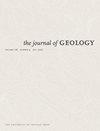U-Pb and Hf Isotopic Evidence on the Sources and Sinks of Grenvillian Detrital Zircons in Early Laurentia
IF 1.3
4区 地球科学
Q2 GEOLOGY
引用次数: 1
Abstract
In situ zircon U-Pb and Hf isotopic data from ∼1.1 Ga intrusive igneous rocks in Mexico and from Grenvillian (0.9–1.3 Ga) detrital zircons in sandstones from the southern midcontinent of Laurentia were used to refine provenance determinations for the Grenvillian detrital zircons delivered to southwestern Laurentia from the Neoproterozoic to the Cambrian and to address the reduction in the Grenvillian detrital zircon abundances documented in Cambrian sandstones from this region. Igneous zircons from Mesoproterozoic anorthosites and granites in northern Sonora have low εHf(0) values (<−22) and could not have been sources of the higher-εHf(0) (>−22), ∼1.1 Ga detrital zircons characteristic of Ediacaran to Terreneuvian sandstones in southwestern Laurentia. Abundant Grenvillian detrital zircons in Cryogenian sandstone injectites from central Colorado have U-Pb ages and high εHf(0) values (>−22) similar to those of zircons in Ediacaran to Terreneuvian sandstones throughout southwestern Laurentia. These zircons were derived from Mesoproterozoic rocks in the Llano uplift and vicinity in Texas and were fluvially transported across southwestern Laurentia from the Cryogenian to the Terreneuvian. In contrast, Cambrian glauconitic sandstones in the subsurface of east-central Colorado and from the Sawatch Sandstone in central Colorado have low Grenvillian zircon abundances, as observed in Cambrian sandstones exposed farther west in Laurentia. The low abundances of Grenvillian detrital zircons in sandstones found both east (Colorado) and west of the strike of a proposed Cambrian “transcontinental arch” suggest that this feature did not disrupt the supply of Llano uplift–derived Grenvillian zircons to southwestern Laurentia. The low Grenvillian zircon abundances instead coincide with the development of marine conditions in south-central Laurentia, suggesting that the progressive encroachment of the Sauk Sea into the continental interior provided a sink for fluvial sediments derived from the Llano uplift that restricted their transport farther to the north and west in the continent.早期劳伦系格伦维尔碎屑锆石来源和沉积的U-Pb和Hf同位素证据
来自墨西哥~1.1 Ga侵入火成岩和劳伦中南部大陆砂岩中的格伦维尔期(0.9–1.3 Ga)碎屑锆石的原位锆石U-Pb和Hf同位素数据用于完善从新元古代到寒武纪输送到劳伦西南部的格伦维尔碎屑锆石的物源测定,并解决该地区寒武纪砂岩中记录的格伦维尔碎屑锆石丰度。索诺拉北部中元古代斜长岩和花岗岩的火成锆石具有较低的εHf(0)值(−22),~1.1 Ga碎屑锆石,具有劳伦斯西南部埃迪卡拉至Terreneuvian砂岩的特征。科罗拉多州中部成冰纪砂岩注入岩中丰富的格伦维尔碎屑锆石具有U-Pb年龄和高εHf(0)值(>−22),类似于整个劳伦西南部埃迪卡拉至Terreneuvian砂岩中的锆石。这些锆石来源于德克萨斯州Llano隆起及其附近的中元古代岩石,从成冰纪到Terreneuvian通过劳伦斯西南部的流体输送。相比之下,科罗拉多州中东部地下的寒武纪海蓝质砂岩和科罗拉多州中部的Sawatch砂岩具有较低的格伦维尔锆石丰度,正如在劳伦蒂亚西部暴露的寒武纪砂岩中观察到的那样。在拟议的寒武纪“横贯大陆拱”走向的东部(科罗拉多州)和西部发现的砂岩中,格伦维尔碎屑锆石的丰度较低,这表明这一特征没有破坏Llano隆起衍生的格伦维尔锆石向劳伦蒂亚西南部的供应。相反,格伦维尔期锆石的低丰度与劳伦斯中南部海洋条件的发展相吻合,这表明索克海对大陆内部的逐渐侵蚀为来自Llano隆起的河流沉积物提供了一个汇点,限制了它们向大陆北部和西部的进一步运输。
本文章由计算机程序翻译,如有差异,请以英文原文为准。
求助全文
约1分钟内获得全文
求助全文
来源期刊

Journal of Geology
地学-地质学
CiteScore
3.50
自引率
5.60%
发文量
0
审稿时长
3 months
期刊介绍:
One of the oldest journals in geology, The Journal of Geology has since 1893 promoted the systematic philosophical and fundamental study of geology.
The Journal publishes original research across a broad range of subfields in geology, including geophysics, geochemistry, sedimentology, geomorphology, petrology, plate tectonics, volcanology, structural geology, mineralogy, and planetary sciences. Many of its articles have wide appeal for geologists, present research of topical relevance, and offer new geological insights through the application of innovative approaches and methods.
 求助内容:
求助内容: 应助结果提醒方式:
应助结果提醒方式:


